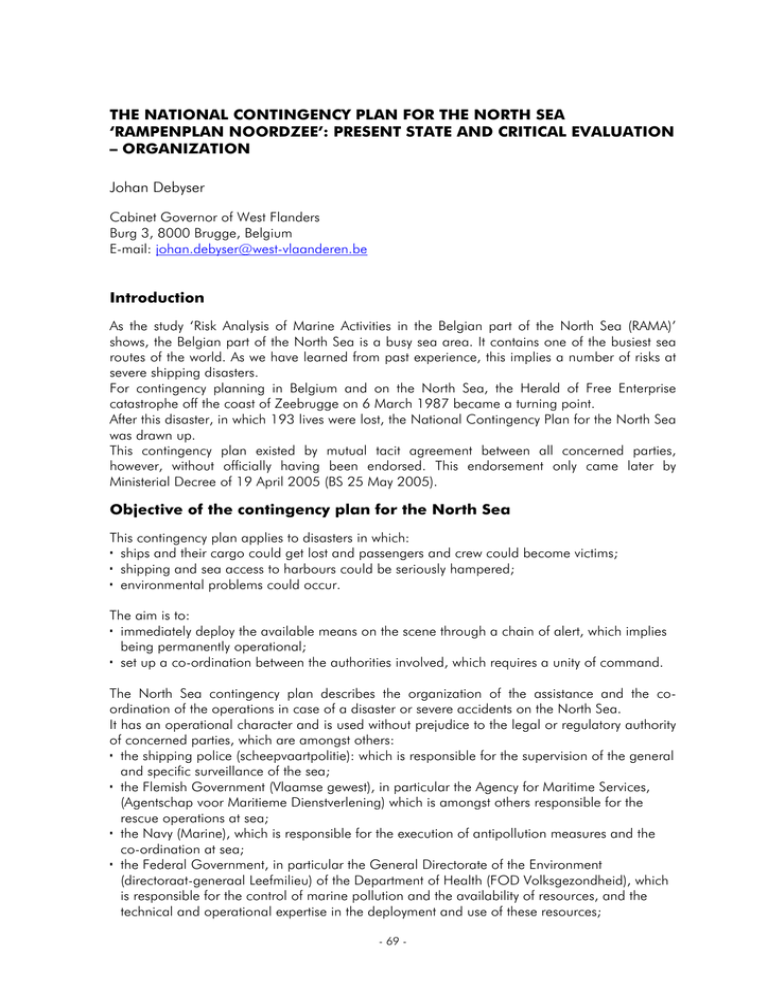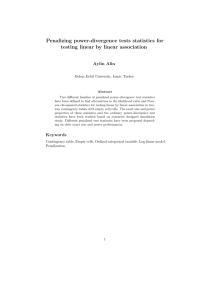THE NATIONAL CONTINGENCY PLAN FOR THE NORTH SEA
advertisement

THE NATIONAL CONTINGENCY PLAN FOR THE NORTH SEA ‘RAMPENPLAN NOORDZEE’: PRESENT STATE AND CRITICAL EVALUATION – ORGANIZATION Johan Debyser Cabinet Governor of West Flanders Burg 3, 8000 Brugge, Belgium E-mail: johan.debyser@west-vlaanderen.be Introduction As the study ‘Risk Analysis of Marine Activities in the Belgian part of the North Sea (RAMA)’ shows, the Belgian part of the North Sea is a busy sea area. It contains one of the busiest sea routes of the world. As we have learned from past experience, this implies a number of risks at severe shipping disasters. For contingency planning in Belgium and on the North Sea, the Herald of Free Enterprise catastrophe off the coast of Zeebrugge on 6 March 1987 became a turning point. After this disaster, in which 193 lives were lost, the National Contingency Plan for the North Sea was drawn up. This contingency plan existed by mutual tacit agreement between all concerned parties, however, without officially having been endorsed. This endorsement only came later by Ministerial Decree of 19 April 2005 (BS 25 May 2005). Objective of the contingency plan for the North Sea This contingency plan applies to disasters in which: ships and their cargo could get lost and passengers and crew could become victims; shipping and sea access to harbours could be seriously hampered; environmental problems could occur. The aim is to: immediately deploy the available means on the scene through a chain of alert, which implies being permanently operational; set up a co-ordination between the authorities involved, which requires a unity of command. The North Sea contingency plan describes the organization of the assistance and the coordination of the operations in case of a disaster or severe accidents on the North Sea. It has an operational character and is used without prejudice to the legal or regulatory authority of concerned parties, which are amongst others: the shipping police (scheepvaartpolitie): which is responsible for the supervision of the general and specific surveillance of the sea; the Flemish Government (Vlaamse gewest), in particular the Agency for Maritime Services, (Agentschap voor Maritieme Dienstverlening) which is amongst others responsible for the rescue operations at sea; the Navy (Marine), which is responsible for the execution of antipollution measures and the co-ordination at sea; the Federal Government, in particular the General Directorate of the Environment (directoraat-generaal Leefmilieu) of the Department of Health (FOD Volksgezondheid), which is responsible for the control of marine pollution and the availability of resources, and the technical and operational expertise in the deployment and use of these resources; - 69 - the Management Unit of the North Sea Mathematical Models (MUMM) (Beheerseenheid Mathematisch Model), which is responsible for the scientific supervision of the marine environment and co-ordinates the scientific activities at sea. The Governor of the province of West Flanders has been appointed General Co-ordinator of the North Sea contingency plan by the Council of Ministers on 11 March 1988. Area of application The North Sea contingency plan applies to the territorial sea, the Exclusive Economical Zone, the Responsibility Zone as stipulated in the Bonn Agreement with reference to sea water pollution control and the rescue zone as determined by FIR with regard to aid and assistance at sea. Moreover, the North Sea contingency plan is also applicable in a number of zones as stipulated in international treaties and which impose on coastal states specific obligations for the open sea, for instance with regard to the rescue of people and marine environmental protection (cf. law of 20 January 1999 for the protection of the marine environment in the sea areas under Belgian jurisdiction). Phasing The contingency plan for the North Sea provides four phases: Phase 1: fore alert by the Nautical Director and assistance through own resources The fore alert is launched as soon as, because of certain circumstances or facts, the risk of a ‘threatening event’ occurring, has considerably increased. The chain of alerts is initiated by the person in charge at the Maritime Rescue and Coordination Centre (MRCC). Phase 2: alert by the Nautical Director and immediate precautions As soon as a threatening event occurs or is on the verge of occurring and when there is serious indication to suspect that the own assistance resources will be insufficient to control the disaster, the person in charge at the Maritime Rescue and Co-ordination Centre (MRCC) proclaims the alert. Here, a chain of alert is followed in order to notify all concerning parties that the plan has been activated. It is important that, if there is any indication of possible victims, the 100 service in Brugge is alerted and the general provincial emergency plan (in particular the medical intervention plan) is activated. Which actions should be taken by the alerted services? In anticipation of co-ordinated assistance, the ships involved must confront the ‘problem’ with their proper resources. The MRCC establishes a reinforced 24 hour permanent service and activates the crisis centre. As soon as possible, the Navy (COMOPSNAV) takes on the task of ‘on scene-co-ordinator’ and leads the interventions at sea. The second phase ends as soon as the co-ordination committee is operational. - 70 - Phase 3: co-ordinated interventions led by the Governor The Governor of West Flanders has been appointed by the federal government as general coordinator of the contingency plan for the North Sea. He can call upon the help of four staffs: a Search and Rescue Staff (SAR) for emergency interventions at sea led by the nautical director. A Pollution Staff (POL) led by the navy with regard to pollution control at sea. Concerning incidents which could affect the harbours, the involved harbour captain is coordinator of the Harbour Staff (HAV). The governor co-ordinates the Land Staff in case of incidents with an onshore impact. Phase 4: after care led by the Governor If there are no more urgent decisions to be made, the general co-ordinator proclaims the after care phase. Evaluation The main objective of this contingency plan is to establish a consultative structure in which various authorities with their specific competences come together under the leadership of the general co-ordinator. In the past, this plan has worked well because of the good understanding between all on-scene parties. However, taking into account various new developments in emergency planning in Belgium, as well as in cooperation between different parties with jurisdiction at sea; this contingency plan for the North Sea needs to be revised. The North Sea contingency plan goes back to a time when emergency planning in Belgium was not efficiently organized. It speaks of four phases, but these phases do not correspond to those which were used in the onshore emergency planning. The Royal Decree of 16 February 2006 on emergency and intervention plans now provides that the policy and the operational intervention co-ordination happens on three levels, which are called phases. There is a municipal phase, a provincial phase and a federal phase. This phasing cannot automatically be applied to the contingency plan for the North Sea, because it is situated outside the municipal and provincial level, but the logic of this threefold phasing could be. Then there would be a first phase in which co-ordination takes place between the different on-scene parties. In the second phase the Governor of West Flanders co-ordinates the activities, such as actually is the case. And if the incident at sea should have national effects, the federal phase could be activated. In this manner, there would be coherence with the onshore emergency planning. The organization of this first phase co-ordination, however, still requires some brainwork. The onshore emergency planning has five ‘disciplines’. The North Sea contingency plan distinguishes four staffs. A better coherence between on and offshore emergency planning is desirable here also. Discipline 1 - on shore refers to assistance and is the task of the fire department and the civil protection service operational units. The SAR staff in the North Sea contingency plan actually corresponds with this first discipline. It relates to everything with regard to immediate assistance at sea and the actual rescues. - 71 - Discipline 2 refers to the medical, sanitary and psychosocial assistance and is provided by the services which give urgent medical aid. The North Sea contingency plan stipulates nothing on this matter. It is therefore desirable to at least refer to the medical intervention plan, and in that plan pay specific attention to victim relief of sea incident victims. Discipline 3 concerns the policing of the emergency site. This task is fulfilled by the federal and/or local police. Again, the contingency plan for the North Sea does not provide anything on that subject. Nonetheless, the federal police, which is in this case the shipping police has important assignments in this respect. Therefore, further elaboration of this discipline is a must. Discipline 4 concerns logistic support and is provided by the operational units of the civil protection service, the fire department and the public and private services specialised in this matter. At sea, we have the Pollution Staff in charge of sea pollution control. This Staff could resort under discipline 4, together with all other services which offer logistic support and are indispensable to efficiently tackle sea incidents. Finally, discipline 5 is about information. In the provincial phase, this is the task of the Governor. The North Sea contingency plan stipulates that the Governor is at all times in charge of all press contacts. In this matter, the onshore emergency planning organization can again be of use in organizing this aspect of the offshore incident control. The importance of an onshore-offshore emergency planning synergy also lies in the drafting of the various contingency plans. Onshore, there should be a multidisciplinary emergency and intervention plan and each discipline needs to have its own monodisciplinary intervention plan. The North Sea contingency plan then will become the multidisciplinary North Sea emergency and intervention plan. Each discipline will then draw up its own monodisciplinary plan. This was already mentioned in the North Sea contingency plan, but rather as a recommendation. It read that each authority involved at interventions at sea was expected to intervene according to its own, previously drafted intervention plan. This is currently being finalised. The MRCC has an operational plan named SAR and there already exists an operational anti pollution intervention plan. A second evolution which the contingency plan for the North Sea should take advantage of, is the putting in place of the Coastguard structure. On 8 July 2005 a cooperation treaty was made between the federal and the Flemish government on the subject of founding and cooperating in a Coastguard structure. The Flemish government has endorsed it by decree of March 17th 2006, the federal government by law of 4 April 2006. Article 26 of this cooperation treaty stipulates that the Governor of West Flanders is the co-ordinator of the contingency plan for the North Sea. This includes the drafting, up-date and co-ordination of the ‘contingency plan for the North Sea’, which deals with all aspects related to disasters at sea and in coastal waters and which are part of the responsibility of all parties involved in this treaty. With this knowledge, the new to be established structures, especially those of the Coastguard centre, the collaboration between the MRCC and the Maritime Information Point (MIK), will have to be taken into account. This yet to be established Coastguard centre, will play an important role in supporting the coordinator and the crisis committee on the subject of gathering of and spreading of information to all parties concerned. - 72 - A third focal point is the definition of the application area of the North Sea contingency plan. As it is now, it is rather limited. It is a definition in which a number of possible incidents are enumerated (for instance shipping accidents with loss of passengers and/or cargo, environmental incidents). A broader definition seems more appropriate, in which is referred to the definition of an emergency situation as mentioned in the Royal Decree on Emergency and Intervention Plans. Under emergency situation the Royal Decree’s legislator reads ‘any event that has or can have damaging effects on social life, such as a severe disruption of public safety, a serious threat to people’s lives or health and/or to important material interests and which requires the coordination of the disciplines to eliminate the threat or restrict damaging effects’. A similar definition might be used in the contingency plan for the North Sea. This broadened definition covers both safety and security incidents, whereas the current definition is limited to safety issues. Safety and security each have their own finality, but in case of a crisis, they are closely linked and can have a big impact on one another. A contingency plan in which both aspects are integrated, which is also reflected in the composition of its crisis committee, should stimulate uniformity of all actions. There will still have to go a lot of thought into this matter and its interpretation during the contingency plan’s revision. Conclusion A contingency plan is not a rigid document in which once and for all is put down how to react in case of an emergency. It is, as such, an evolving matter, which entails that the plan should constantly be adjusted to changing circumstances. This is surely the case for the North Sea contingency plan. Sometimes there is a need for small but necessary adjustments, but in due course one should dare to question the totality of it all and submit it to major changes. The contingency plan for the North Sea is currently at that point in time. This revision will still require a lot more energy, deliberation and effort of all parties concerned. Nonetheless, it is an important assignment. Belgium may only count 65 kilometres of coast and have the authority on only a very small part of the North Sea, but the potential risks and dangers are substantial and realistic. Therefore, risk analysis is an important tool to assess these potential risks. It is the task of the appointed authorities to take them into consideration and take the necessary precautions. It is in this view that the Governor of West Flanders wishes to observe his role as co-ordinator of the contingency plan for the North Sea and desires to permanently evaluate, question and revise this emergency plan. - 73 -


